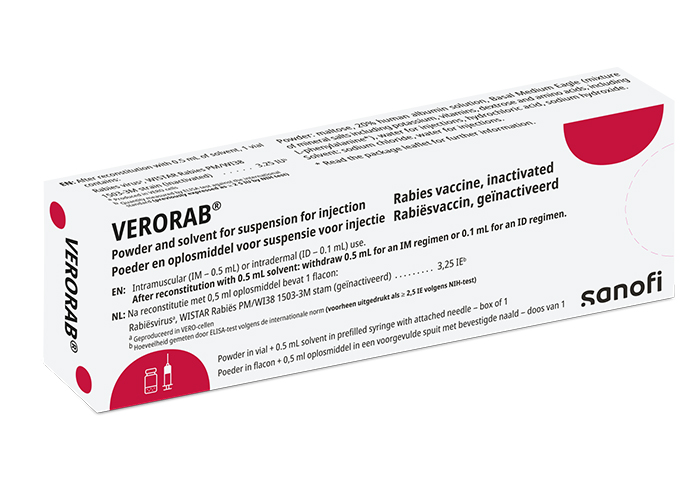
Summary

Verorab is indicated for pre-exposure prophylaxis (PrEP) and post-exposure prophylaxis (PEP) against rabies in all age groups.1
Verorab should be used according to official recommendations.
| D0 | D7 | D21 or D28 | |
| Three-dose regimen IM route - 0.5 mL | 1 dose | 1 dose | 1 dose |
| One-week regimen IM route 0.5 mLa | 1 dose | 1 dose | |
| Intrademal route (0.1 mL per dose) | |||
| One-week regimen ID route 0.5 mLa | 2 doses b | 2 doses b |
a - This regimen should not e used for immuneocompromised individuals (see subsection "Immunocompromised individuals")
b - One injection in each arm (for adults and children) or each anterolateral thigh (infants and toddlers)
Booster doses are determined based on the risk of exposure and on serological tests to detect the presence of rabies virus-neutralising antibodies (≥ 0.5 IU/ml).
A booster dose consists of one dose of 0.5 mL given by intramuscular route or one dose of 0.1 mL given by intradermal route in accordance with WHO recommendations.
Verorab can be administered as a booster injection after primary vaccination with a cell culture rabies vaccine (a rabies vaccine prepared in Vero cells or prepared in human diploid cells (HDCV)).
Immunocompromised individuals:
3-dose regimen should be used and serology test done 2-4 weeks after last dose to confirm seroprotection (additional injections may be needed)
Rapid immunogenicity as early as 2 weeks after the final PrEP or PEP doses1
| AGE GROUP | VERY COMMON* SYSTEMIC AEs | COMMON* SYSTEMIC AEs |
| Adults ≥18 years old | Malaise, headache, myalgia, injection site pain (IM use), Injection site pain (ID use), Injection site erythema (ID use) | Lymphadenopathy, influenza-like syndrome, fever, Injection site erythema (IM use), Injection site pruritus (ID & IM use), Injection site swelling (ID & IM use), and Injection site induration (IM use) |
| Paediatric population <18 years old | Malaise, headache and myalgia Irritability, somnolence and inconsolbale crying (in infants/young children), Injection site pain (ID & IM use), Injection site erythema (ID use), Injection site swelling (ID use) | Lymphadenopathy and fever Insomnia (in infants/young children), Injection site erythema (IM use), Injection site swelling (IM use) |
Refer to SMPC for full list of adverse reactions.
* Within each system organ class, adverse reactions are ranked under headings of frequency using the following convention:
- very common (≥ 1/10);
- common (≥ 1/100 and <1/10);
.

References
- UK Summary of Product Characteristics (SmPC) - Verorab - January 2025
MAT-XU-2400750 (v4.0) Date of preparation: May 2025